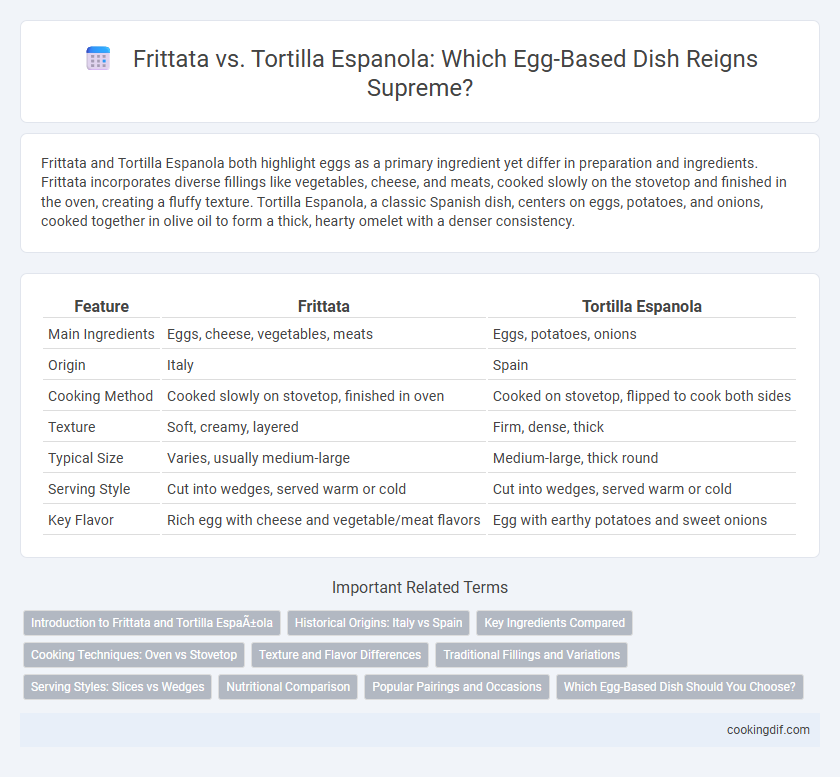Frittata and Tortilla Espanola both highlight eggs as a primary ingredient yet differ in preparation and ingredients. Frittata incorporates diverse fillings like vegetables, cheese, and meats, cooked slowly on the stovetop and finished in the oven, creating a fluffy texture. Tortilla Espanola, a classic Spanish dish, centers on eggs, potatoes, and onions, cooked together in olive oil to form a thick, hearty omelet with a denser consistency.
Table of Comparison
| Feature | Frittata | Tortilla Espanola |
|---|---|---|
| Main Ingredients | Eggs, cheese, vegetables, meats | Eggs, potatoes, onions |
| Origin | Italy | Spain |
| Cooking Method | Cooked slowly on stovetop, finished in oven | Cooked on stovetop, flipped to cook both sides |
| Texture | Soft, creamy, layered | Firm, dense, thick |
| Typical Size | Varies, usually medium-large | Medium-large, thick round |
| Serving Style | Cut into wedges, served warm or cold | Cut into wedges, served warm or cold |
| Key Flavor | Rich egg with cheese and vegetable/meat flavors | Egg with earthy potatoes and sweet onions |
Introduction to Frittata and Tortilla Española
Frittata and Tortilla Espanola are both versatile egg-based dishes with distinct regional origins, Italian and Spanish respectively. Frittata typically includes a variety of fillings like vegetables, cheeses, and meats mixed into beaten eggs and cooked slowly, often finished under a broiler. Tortilla Espanola features a thick omelette composed primarily of eggs, potatoes, and onions, cooked slowly to develop a firm, hearty texture characteristic of traditional Spanish cuisine.
Historical Origins: Italy vs Spain
Frittata, originating from Italy, traces back to ancient Roman times as a versatile egg dish often combined with vegetables, cheeses, and meats, reflecting Mediterranean culinary traditions. In contrast, Tortilla Espanola, rooted in Spain since the early 19th century, features a simple yet hearty blend of eggs, potatoes, and onions, symbolizing Spanish rural cuisine. Both dishes embody regional ingredient availability and cultural influences, highlighting Italy's diverse flavor profiles versus Spain's emphasis on staple, rustic ingredients.
Key Ingredients Compared
Frittata incorporates beaten eggs mixed with a variety of ingredients such as cheese, vegetables, and meats, cooked slowly without flipping, creating a creamy interior. Tortilla Espanola primarily features eggs combined with thinly sliced potatoes and onions, cooked in olive oil and flipped to achieve a firm, thick texture. The key difference lies in the addition of potatoes in Tortilla Espanola, making it heartier, while frittatas emphasize a diverse range of fillings for varied flavors and textures.
Cooking Techniques: Oven vs Stovetop
Frittata is typically finished in the oven, allowing even cooking and a fluffy texture as the eggs set uniformly. Tortilla Espanola is cooked entirely on the stovetop, with slow, gentle heat used to cook and flip the thick potato and egg mixture, creating a denser, custard-like consistency. The oven method of the frittata enhances volume and slight browning on top, whereas the stovetop technique of the tortilla espanola produces a tender, golden crust on both sides.
Texture and Flavor Differences
Frittata offers a fluffy, creamy texture with rich, savory flavors from fresh herbs and cheese, enhancing each bite with a delicate mouthfeel. In contrast, Tortilla Espanola features a denser, hearty consistency due to slow-cooked potatoes and onions, delivering a robust, earthy flavor profile. These textural and flavor distinctions define their unique appeal within egg-based dishes.
Traditional Fillings and Variations
Frittata traditionally features fillings like cheese, spinach, mushrooms, and meats such as sausage or ham, offering a creamy, open-faced omelet texture. Tortilla Espanola centers on classic ingredients like potatoes and onions, slowly cooked to create a dense, thick Spanish omelet. Variations of frittata often include diverse vegetables and cheeses, while tortilla espanola maintains its signature simplicity with occasional additions like chorizo or bell peppers.
Serving Styles: Slices vs Wedges
Frittata is typically served in wedges, allowing for easy sharing and presentation, while Tortilla Espanola is commonly sliced into smaller, more uniform pieces ideal for tapas or appetizers. The wedge presentation of a frittata highlights its fluffy, layered texture, contrasting with the denser, more compact nature of the tortilla slices. Both serving styles enhance the dishes' unique textures and complement diverse dining settings, from casual gatherings to more formal meals.
Nutritional Comparison
Frittata typically contains a higher amount of protein due to the inclusion of cheese, vegetables, and sometimes meats, making it richer in calories and fat compared to Tortilla Espanola, which primarily relies on eggs and potatoes. Tortilla Espanola has a higher carbohydrate content because of the potatoes and generally contains less saturated fat. Both dishes provide essential nutrients like vitamins A, D, and B12, but frittata's diverse ingredients contribute to a broader micronutrient profile.
Popular Pairings and Occasions
Frittata pairs excellently with fresh herbs like basil, parsley, and chives, often served at brunch or light lunch gatherings, highlighting seasonal vegetables and cheeses. Tortilla Espanola, rich with potatoes and onions, is traditionally accompanied by crusty bread and olives, making it a staple for tapas or casual family dinners in Spanish culture. Both dishes are versatile egg-based meals, yet Frittata emphasizes a broader range of mix-ins for varied occasions, while Tortilla Espanola remains a comforting, rustic choice.
Which Egg-Based Dish Should You Choose?
Choosing between frittata and tortilla espanola depends on texture and ingredients preference; frittata offers a fluffy, open-faced egg dish with various mix-ins like vegetables and cheese, while tortilla espanola features a denser, hearty combination of eggs, potatoes, and onions. Frittatas cook quickly on stovetop and finish under a broiler, making them versatile for customization, whereas tortilla espanola requires slow cooking of potatoes and onions in olive oil before combining with eggs. Both dishes deliver rich flavors and protein, but frittata suits lighter, more diverse ingredient options, and tortilla espanola appeals to those seeking traditional Spanish comfort food.
Frittata vs Tortilla Española for egg-based dish Infographic

 cookingdif.com
cookingdif.com